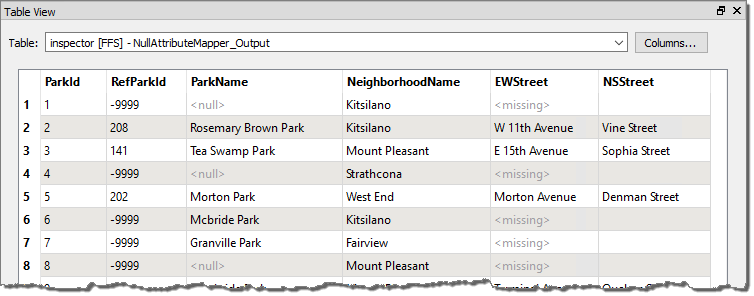Null Attributes
Null attributes are a very important part of FME’s attribute handling. Not every dataset has null values, and not every format supports them; but when they do exist it is important for FME to handle them correctly.
What is a Null Value?
In general, a null attribute value is the equivalent of nothing. However, it’s important to be precise in our terminology because there are many ways to represent nothing:
- An attribute has a particular state that indicates nothingness (null)
- An attribute has a particular value that indicates nothingness (for example, -999)
- An attribute exists but has no value (empty)
- An attribute doesn’t exist (missing)
- A numeric attribute is NaN (Not a Number)
- A numeric attribute has a value of zero
In fact, Safe Software’s developers have identified fifteen (15) different ways for “nothing” to be represented in spatial and tabular data.
| Professor Lynn Guistic says… |
| In case you are wondering, yes, our developers were the subject of many jokes for having spent six months "working on nothing"! |
So when we talk about null, it has a particular meaning. For us, a null is a specific state that is deliberately set to signify that the information does not exist. It tells us that the lack of information is not a mistake, as a missing or empty value might be.
Because there are so many different methods, this section will discuss ways to handle "nothing" attribute values, but with a particular emphasis on Null values.
How does FME Represent Nothing?
FME’s internal engine has its own state to represent null. However, when presented to the user, a null value is usually represented as <null>.
For example, this feature in the Logger has <null> for the ParkName attribute:

Similarly, the FME Data Inspector will depict nulls as <null>:

Notice how we have a wide range of "nothing" values here. The ParkName is a true <null>, the RefParkId has a value of -9999, EWStreets are <missing>, and NSStreet is blank (meaning the attribute exists but is empty).
| Professor Lynn Guistic says… |
|
<missing> is an interesting concept. You might be asking, "how do we know when an attribute is missing"? But a better question is "how do we know that the attribute should exist"?
We know it should exist because it appears in the schema defined in a reader. For example, in the above screenshot, NSStreet appears in the schema, but for some reason certain features do not have that attribute. |